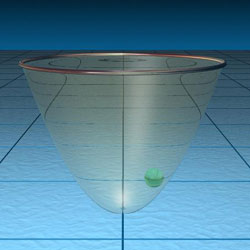Twisty Tweezers

Using only a laser beam, researchers can spin a microscopic bead, but they can’t measure or control the twisting force. Now reports in the September 2003 Physical Review A and the 14 May PRL demonstrate that the twisting force, or torque, can be measured by analyzing the light passing through the object. The PRL paper also shows how to control the torque by creating what the authors call an “optical torque wrench.” The technique could be useful for exploring cellular machinery such as molecular motors or the proteins that replicate DNA.
Optical tweezers use a focused laser beam to trap a microscopic object, usually one that is immersed in water. If the object starts to wander away, the laser light is deflected, pushing the object back towards the focus. Researchers can tug on small structures, like those in cells, and control the applied forces very precisely. The light also exerts a torque if it pushes differently on different parts of a particle. But because this torque depends on the detailed shape of the beam near the focus, it’s hard to know exactly how big the torque is.
A simpler way to twist a particle is to use the light’s polarization–the direction of its oscillating electric field. In Physical Review A Halina Rubinsztein-Dunlop and her team at the University of Queensland, in Brisbane, Australia, report measuring the torque on a short, micrometer-sized glass rod. After trapping the rod in their optical tweezers, they polarized the trapping light, so that its electric field pointed in a single direction. The field pushed positive and negative charges in opposite directions along the length of the rod, creating a so-called electric dipole–the electric field equivalent of a bar magnet. As a result, the rod felt a torque trying to line it up with the field, just as a bar magnet or compass needle tries to align with the Earth’s magnetic field.
To measure that torque, the team analyzed the polarization of the light coming out, and found that the electric field was rotating slightly in the direction opposite to the torque. The torques they measured for different rod sizes agreed well with their mathematical models. Rubinsztein-Dunlop says they have very recently used a similar technique with spherical particles to precisely measure the viscosity of microscopic fluid samples [1].
In PRL, Arthur La Porta and Michelle Wang of Cornell University, in Ithaca, New York, report similar measurements of the torque on tiny, irregular quartz particles. In these particles, the dipole that tries to align with the light’s electric field arises from the quartz crystal structure, rather than from the particle’s shape. The Cornell team added a new feature, creating what they call an “optical torque wrench.” They monitored the torque on a rotating particle moment-by-moment and used this information to control the light’s polarization. Their system continually rotates the polarization to keep the torque constant. Wang says that when this type of feedback was added to traditional optical tweezers it made the tool “much more powerful.”
David Grier of New York University says that researchers are already rotating biological objects with another technique called magnetic tweezers. But “the more people see that you can do useful things with the polarization, the more likely it is that really interesting things can come out of it.” For example, researchers could use two traps to twist nearby objects in a cell in opposite directions, he says.
–Don Monroe
Don Monroe is a freelance science writer in Murray Hill, New Jersey.
References
- A. I. Bishop, T. A. Nieminen, N. R. Heckenberg, and H. Rubinsztein-Dunlop, “Optical microrheology using rotating laser-trapped particles,” Phys. Rev. Lett 92 198104 (2004)
More Information
Light’s polarization is sometimes referred to as “spin angular momentum.” Light can also carry orbital angular momentum, which can also exert a torque, as described in Physics Today, May 2004, page 35 (requires subscription).


